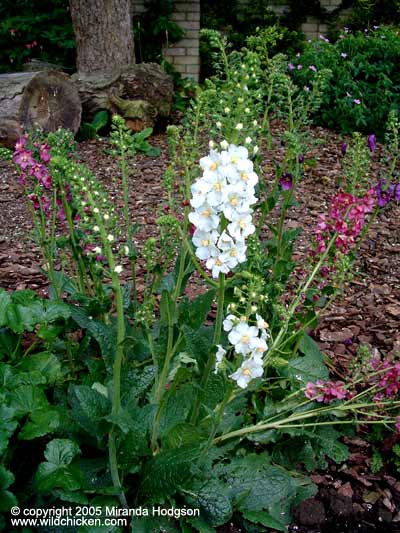

Verbascum phoeniceum (also called purple mullein)
Verbascum
phoeniceum
Short lived herbaceous perennial grown for spires of flowers in pink, purple and white. Good for mixed borders and wildlife gardens, but not suitable for containers as they do better in open ground.
V. phoeniceum is often sold as a hybrid but according to the RHS, this is not really correct; they are not hybrids, but a mix of different colours amongst a very variable species.
Some report this plant as a biennial, dying after flowering once, but it's in to its third year here. At least, there are rosettes of healthy looking leaves coming up so I'm hoping the plants will flower again. I have to say that the first-year plants, grown from seed, were pretty spindly, with weak stems, and I nearly rooted them all out. The following year, they were much sturdier with larger flowers and thicker stems and I decided to keep them.
Flowers throughout the summer.
Habit - upright to slightly lax, forming clumps. H: 1m S: 30cm.
Stem - straight, vertically ridged, with the narrower top tending to curl under until the flower buds get bigger.
Leaves - oval, forming a rosette, soft texture, mid-green.
Flowers - cup-shaped in shades of white, pink and purple, with yellow centres.
Sun to very light shade, though does best in sun.
Grows in poor, well-drained soil and prefers chalk.
Hardy.
Remove faded flower spikes to encourage a second flowering later in the summer. May need support if grown in a windy situation or if other supporting plants are not grown next to it.
Verbascums are prone to attack by the caterpillar of the mullein moth, Cucullia verbasci, which can eat a plant's entire foliage in a day. They are often seen in surprisingly large numbers on one plant, all stuffing themselves solid with Verbascum. They are easily recognisable, when they emerge in early summer, as they are clearly marked in bright yellow and black. Check the plants regularly and pick off the caterpillars off.
Sometimes you will see what is called fasciation on Verbascums. This is where the flowering parts appear squashed or flattened, with the tops divided in two. No one really seems to know what causes fasciation, but it isn't a disease and is thought to be the result of one of a number of things: frost, physical damage by insects, a bacteria, temperature or a hormone imbalance. It is recommended not to propagate from plants showing fasciation.
Best done by root cuttings, which can be taken with the plant still in situ in the ground.
Work down into the soil and cut a pencil-thick section of root, about 5cm long, from near the base of the plant. Lay on sandy compost in a seed tray, cover with compost/perlite, water well and allow to drain. Don't let them dry out. The cutting will produce new buds before roots so don't remove them from the tray till you see roots appear through the drainage holes. Grow on in small pots and plant out in spring.
Garden Plant Information list of plant care info by botanical name